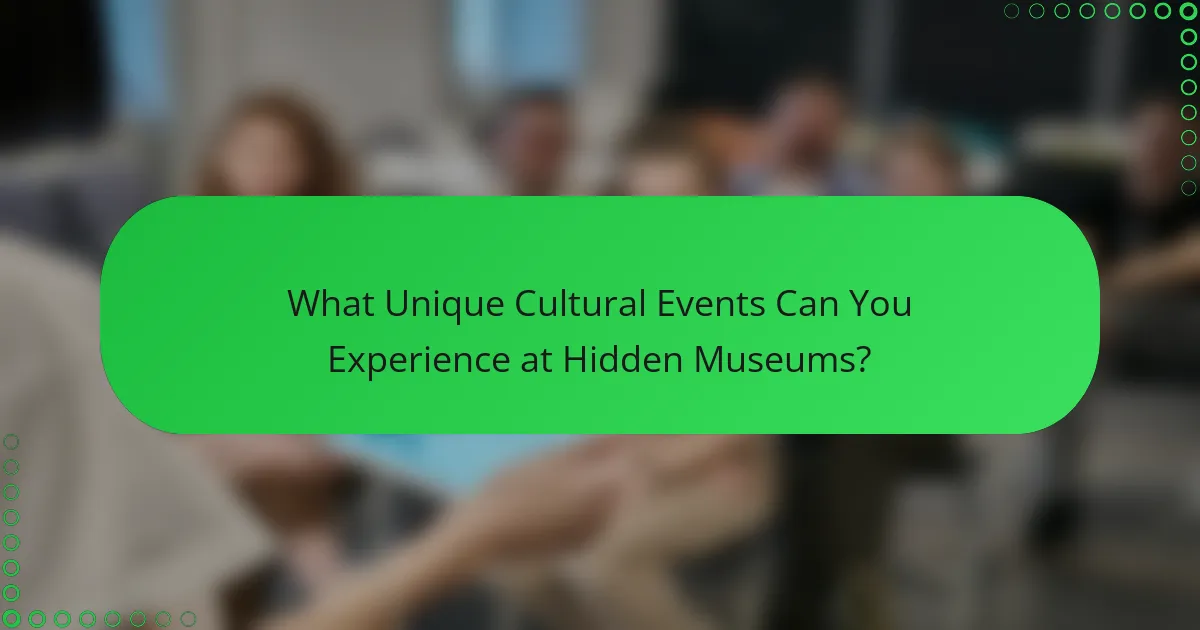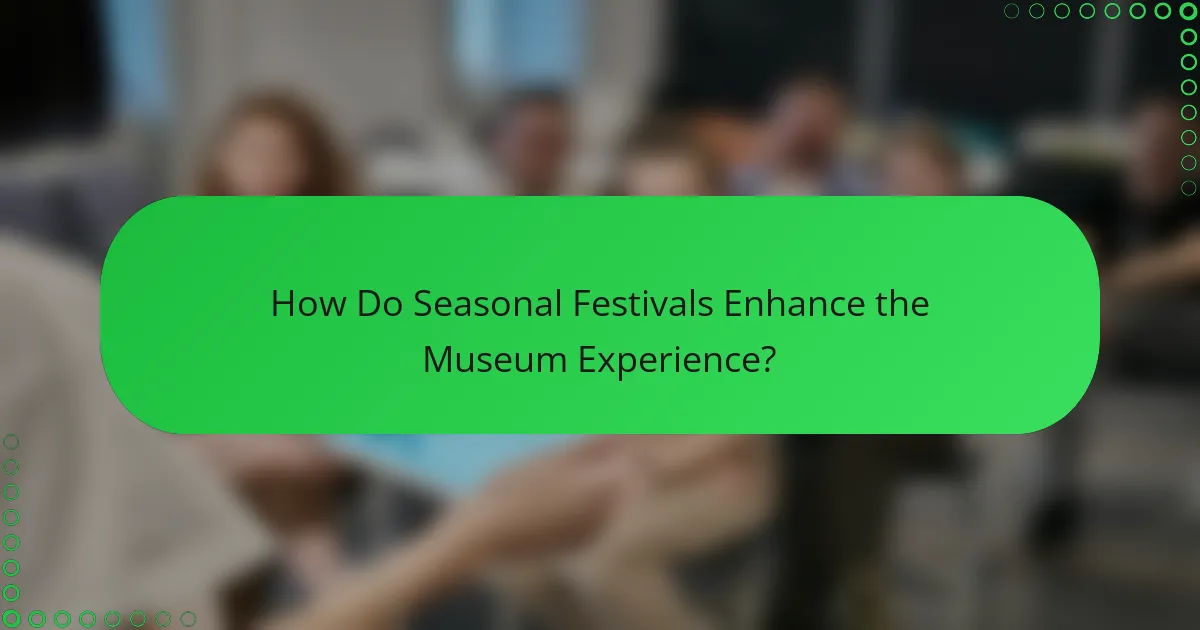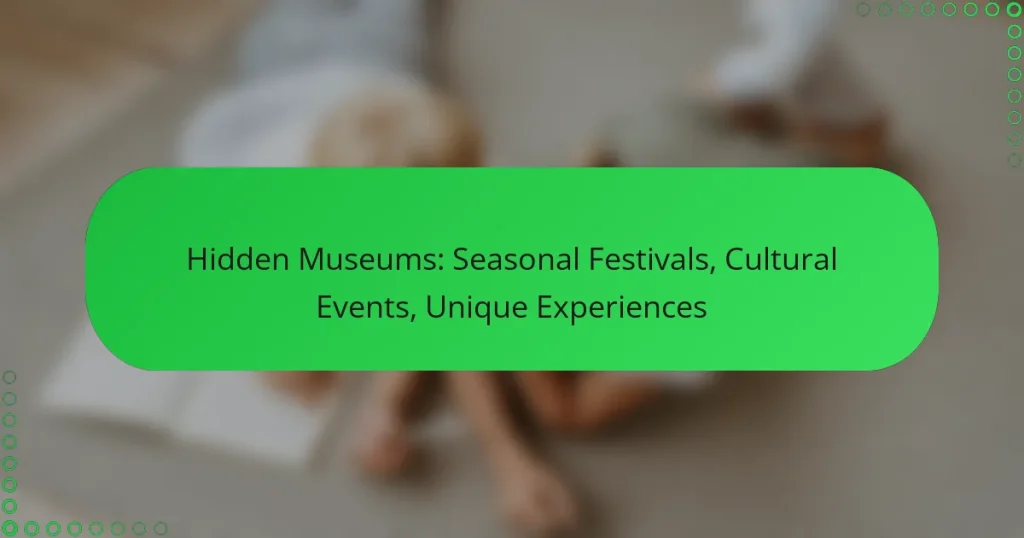Hidden museums offer a treasure trove of seasonal festivals and cultural events that immerse visitors in local traditions and artistic expressions. These unique experiences not only enhance the museum visit but also foster a deeper connection with the community’s history and culture through interactive programming and themed activities.

What Are the Best Hidden Museums for Seasonal Festivals?
Hidden museums often host seasonal festivals that showcase unique cultural experiences. These events provide an opportunity to engage with local traditions, art, and history in a more intimate setting.
Smithsonian National Museum of American History
The Smithsonian National Museum of American History in Washington, D.C. features seasonal festivals that celebrate American culture and heritage. Events often include live performances, hands-on activities, and special exhibitions that highlight various aspects of U.S. history.
During the summer, the museum may host outdoor festivals with food trucks and local artisans, making it a vibrant place to explore. Check the museum’s calendar for specific dates and themes to plan your visit accordingly.
Los Angeles County Museum of Art
The Los Angeles County Museum of Art (LACMA) offers seasonal events that connect visitors with art and culture through festivals. These events often feature live music, dance performances, and interactive art installations.
For example, the annual “LACMA Art + Film Gala” celebrates the intersection of art and cinema, drawing crowds from around the region. Be sure to look for family-friendly activities during school holidays, which can enhance your experience.
New York City’s Tenement Museum
New York City’s Tenement Museum focuses on the immigrant experience and hosts seasonal festivals that reflect the diverse cultures of its residents. Events often include storytelling, food tastings, and workshops that engage visitors with the history of the Lower East Side.
During the winter holidays, the museum may offer special programs that explore immigrant traditions, making it a unique way to learn about cultural heritage. Reservations are recommended, as these events can fill up quickly.
Chicago’s Museum of Science and Industry
Chicago’s Museum of Science and Industry features seasonal festivals that blend science with fun. Events like “Science Chicago” highlight interactive exhibits and demonstrations, making learning enjoyable for all ages.
During the summer months, the museum often hosts outdoor science fairs and workshops that encourage hands-on participation. Check their website for upcoming events and ticketing information to ensure a smooth visit.
Philadelphia’s Magic Gardens
Philadelphia’s Magic Gardens is a unique outdoor mosaic art installation that hosts seasonal festivals celebrating local artists and community culture. These events often include live music, art workshops, and guided tours of the gardens.
In the spring, the garden may host a “Spring Fling” festival, featuring local food vendors and craft activities for families. Admission fees vary, so consider purchasing tickets in advance for special events to avoid long lines.

What Unique Cultural Events Can You Experience at Hidden Museums?
Hidden museums often host unique cultural events that provide immersive experiences, showcasing local traditions and artistic expressions. These events allow visitors to engage with art and culture in a more personal and interactive way.
Annual Cherry Blossom Festival at the National Gallery of Art
The Annual Cherry Blossom Festival at the National Gallery of Art celebrates the beauty of spring with a variety of activities, including art exhibitions and cultural performances. This festival typically occurs in March and April, coinciding with the blooming of cherry blossom trees around Washington, D.C.
Visitors can enjoy guided tours, workshops, and live music, all inspired by the themes of renewal and nature. It’s advisable to check the gallery’s website for specific dates and event schedules, as they may vary each year.
Art in the Park at the Denver Art Museum
Art in the Park is a seasonal event hosted by the Denver Art Museum, usually taking place during the summer months. This event transforms the museum’s outdoor spaces into vibrant art installations and interactive workshops, encouraging creativity among attendees of all ages.
Participants can engage in hands-on activities, enjoy live performances, and explore temporary art exhibits. Admission to the park events is often free, but some workshops may require a small fee or advance registration, so checking the museum’s calendar is recommended.
Night at the Museum events at the Field Museum
Night at the Museum events at the Field Museum offer a unique opportunity to explore the museum after hours. These events typically include themed activities, special exhibitions, and guided tours, providing a different perspective on the museum’s collections.
Tickets for these events often sell out quickly, so it’s wise to purchase them in advance. Attendees can expect a lively atmosphere with food and drinks available for purchase, making it a great option for a night out with friends or family.

How Do Seasonal Festivals Enhance the Museum Experience?
Seasonal festivals significantly enrich the museum experience by offering unique opportunities for engagement and learning. These events often feature interactive elements, special programming, and themed activities that draw in diverse audiences and create memorable experiences.
Interactive exhibits during festivals
During seasonal festivals, museums frequently introduce interactive exhibits that encourage hands-on participation. These exhibits may include immersive installations, live demonstrations, or technology-driven experiences that allow visitors to engage directly with the content. For example, a science museum might host a robotics workshop where attendees can build and program their own robots.
Such interactive elements not only make learning enjoyable but also cater to various age groups, enhancing accessibility and interest. Visitors are more likely to retain information when they actively participate in the experience rather than passively observing.
Special guest speakers and workshops
Festivals often feature special guest speakers and workshops led by experts in relevant fields. These sessions provide attendees with insights from professionals, fostering a deeper understanding of the subjects at hand. For instance, an art museum might invite a renowned artist to discuss their creative process and offer a live demonstration.
Workshops can vary in length and complexity, catering to different skill levels and interests. Participants can gain practical skills or new perspectives, making the festival a valuable educational opportunity.
Themed tours and activities
Themed tours and activities are a hallmark of seasonal festivals, allowing visitors to explore specific topics in depth. These tours may focus on particular exhibits, historical periods, or cultural themes, providing a curated experience that enhances appreciation for the museum’s offerings. For example, a history museum might offer a guided tour centered on local heritage during a cultural festival.
Activities such as scavenger hunts or storytelling sessions can further engage visitors, encouraging exploration and interaction with the museum’s collection. These themed experiences not only entertain but also promote a sense of community among attendees, making the festival a shared cultural celebration.

What Criteria Should You Consider When Choosing a Hidden Museum?
When selecting a hidden museum, consider factors such as location, accessibility, the type of exhibits and events offered, and visitor reviews. These criteria will help ensure a fulfilling and enjoyable experience tailored to your interests and needs.
Location and accessibility
Location plays a crucial role in choosing a hidden museum. Look for museums that are conveniently situated near public transportation or major attractions to minimize travel time. Accessibility features, such as ramps and elevators, are also important for visitors with mobility challenges.
Check the museum’s operating hours and any seasonal variations in accessibility. Some hidden museums may have limited hours or require advance reservations, especially during peak tourist seasons.
Type of exhibits and events offered
Different hidden museums specialize in various themes, from local history to contemporary art. Research the types of exhibits and events they host to find one that aligns with your interests. Some may offer interactive experiences, workshops, or seasonal festivals that enhance your visit.
Consider whether the museum features rotating exhibits or permanent collections, as this can affect the variety of experiences available during your visit. Look for unique events that may coincide with your trip, such as cultural festivals or special guided tours.
Visitor reviews and recommendations
Reading visitor reviews can provide valuable insights into the quality of a hidden museum. Look for feedback on the overall experience, including the friendliness of staff, cleanliness, and the educational value of exhibits. Websites like TripAdvisor or Google Reviews can be helpful resources.
Ask friends or family for recommendations, especially if they have visited hidden museums in the area. Personal experiences can guide you toward the best options and help you avoid potential disappointments.

What Are the Pricing Options for Visiting Hidden Museums?
Pricing options for visiting hidden museums can vary widely, often depending on the location, type of museum, and specific events or exhibitions. Generally, visitors can expect a mix of general admission fees, membership models, and discounts for certain groups.
General admission fees
General admission fees for hidden museums typically range from around $5 to $20 per person. Some museums may charge higher prices for special exhibitions or events. It’s advisable to check the museum’s website for current pricing and any special promotions that may be available.
Many museums offer free admission on specific days or times, which can be a great way to explore without spending money. Keep an eye on local listings for such opportunities.
Membership and subscription models
Membership and subscription models provide a cost-effective way for frequent visitors to enjoy hidden museums. Memberships often range from $50 to $150 annually and may include benefits like unlimited visits, guest passes, and discounts at museum shops.
Some museums offer tiered membership levels, allowing visitors to choose a plan that best fits their needs. Subscriptions may also include exclusive access to events and previews of new exhibitions.
Discounts for students and seniors
Many hidden museums offer discounts for students and seniors, typically ranging from 10% to 50% off general admission prices. Students usually need to present a valid ID, while seniors may need to show proof of age.
It’s wise to inquire about these discounts when purchasing tickets, as some museums may have specific days dedicated to reduced pricing for these groups. Always check the museum’s policy to ensure eligibility for discounts.

How Can Online Courses Enhance Your Understanding of Hidden Museums?
Online courses can significantly deepen your understanding of hidden museums by providing specialized knowledge and insights into their unique collections and curation practices. These courses often cover topics such as museum management, exhibit design, and the cultural significance of lesser-known institutions.
Courses on museum curation
Courses on museum curation focus on the skills and knowledge required to manage and present museum collections effectively. They typically cover topics such as collection management, exhibition planning, and audience engagement strategies. Many programs also emphasize the importance of storytelling in curation, helping students learn how to create compelling narratives around artifacts.
When selecting a course, consider the format and duration that best fits your schedule. Many online courses are self-paced, allowing you to learn at your convenience, while others may have set timelines with live sessions. Look for programs that offer practical assignments or projects, as these can provide valuable hands-on experience.
Common pitfalls to avoid include enrolling in courses that lack accreditation or recognition in the field. Research the institution offering the course and read reviews from past students to ensure it meets your educational needs. Additionally, consider courses that provide networking opportunities with professionals in the museum sector, as these connections can be beneficial for your career.


